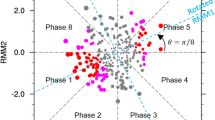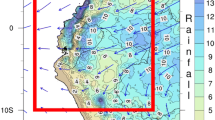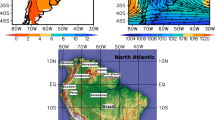Abstract
The regional influence of the Madden–Julian oscillation (MJO) on South America is described. Maps of probability of weekly-averaged rainfall exceeding the upper tercile were computed for all seasons and related statistically with the phase of the MJO as characterized by the Wheeler–Hendon real-time multivariate MJO (RMM) index and with the OLR MJO Index. The accompanying surface air temperature and circulation anomalies were also calculated. The influence of the MJO on regional scales along with their marked seasonal variations was documented. During December–February when the South American monsoon system is active, chances of enhanced rainfall are observed in southeastern South America (SESA) region mainly during RMM phases 3 and 4, accompanied by cold anomalies in the extratropics, while enhanced rainfall in the South Atlantic Convergence Zone (SACZ) region is observed in phases 8 and 1. The SESA (SACZ) signal is characterized by upper-level convergence (divergence) over tropical South America and a cyclonic (anticyclonic) anomaly near the southern tip of the continent. Impacts during March–May are similar, but attenuated in the extratropics. Conversely, in June–November, reduced rainfall and cold anomalies are observed near the coast of the SACZ region during phases 4 and 5, favored by upper-level convergence over tropical South America and an anticyclonic anomaly over southern South America. In September–November, enhanced rainfall and upper-level divergence are observed in the SACZ region during phases 7 and 8. These signals are generated primarily through the propagation of Rossby wave energy generated in the region of anomalous heating associated with the MJO.














Similar content being viewed by others
References
Alvarez MS, Vera CS, Kiladis GN, Liebmann B (2014) Intraseasonal variability in South America during the cold season. Clim Dyn 42(11–12):3253–3269. doi:10.1007/s00382-013-1872-z
Barlow M, Salstein D (2006) Summertime influence of the Madden–Julian oscillation on daily rainfall over Mexico and Central America. Geophys Res Lett 33:L21708. doi:10.1029/2006GL027738
Barret BS, Carrasco JF, Testino AP (2012) Madden–Julian oscillation (MJO) modulation of atmospheric circulation and Chilean winter precipitation. J Clim 25(5):1678–1688
Berbery EH, Nogues-Paegle J (1993) Intraseasonal interactions between the tropics and extratropics in the Southern Hemisphere. J Atmos Sci 50(13):1950–1965
Carvalho LMV, Jones C, Liebmann B (2004) The South Atlantic convergence zone: intensity, form, persistence, relationships with intraseasonal to interannual activity and extreme rainfall. J Clim 17:88–108
Cerne B, Vera C (2011) Influence of the intraseasonal variability on heat waves in subtropical South America. Clim Dyn 36:2265–2277
Cerne B, Vera CS, Liebmann B (2007) The nature of a heat wave in eastern Argentina occurring during SALLJEX. Mon Weather Rev 135:1165–1174
De Souza EB, Ambrizzi T (2006) Modulation of the intraseasonal rainfall over tropical Brazil by the Madden–Julian oscillation. Int J Clim 26(13):1759–1776
Donald A, Meinke H, Power B, deMaia AHN, Wheeler MC, White N, Stone RC, Ribbe J (2006) Near-global impact of the Madden–Julian oscillation on rainfall. Geophys Res Lett 33:L09704. doi:10.1029/2005GL025155
Gonzalez PLM, Vera CS (2013) Summer precipitation variability over South America on long and short intraseasonal timescales. Clim Dyn. doi:10.1007/s00382-013-2023-2
Jones C, Waliser DE, Lau KM, Stern W (2004) Global occurrences of extreme precipitation events and the Madden–Julian oscillation: observations and predictability. J Clim 17:4575–4589
Jones C, Gottschalck J, Carvalho LMV, Higgins WR (2011) Influence of the Madden–Julian oscillation on forecasts of extreme precipitation in the contiguous United States. Mon Weather Rev 139:332–350
Kalnay E et al (1996) The NCEP/NCAR 40-year reanalysis project. Bull Am Meteorol Soc 77(3):437–471
Kidson JW (1999) Principal modes of Southern Hemisphere low-frequency variability obtained from NCEP-NCAR reanalyses. J Clim 12(9):2808–2830
Kiladis GN, Mo KC (1998) Interannual and intraseasonal variability in the Southern Hemisphere. In: Karoly DJ, Vincent DG (eds) Meteorology of the Southern Hemisphere. American Meteorological Society, Boston, MA, pp 307–336
Kiladis GN, Dias J, Straub KH, Wheeler MC, Tulich SN, Kikuchi K, Weickmann KM, Ventrice MJ (2014) A comparison of OLR and circulation-based indices for tracking the MJO. Mon Weather Rev 142:1697–1715
Lau WKM, Waliser DE (2012) Intraseasonal variability of the atmosphere–ocean climate system, 2nd edn. Springer, Heidelberg, p 613
Liebmann B, Allured D (2005) Daily precipitation grids for South America. Bull Am Meteorol Soc 86(11):1567–1570
Liebmann B, Kiladis GN, Marengo JA, Ambrizzi T, Glick JD (1999) Submonthly convective variability over South America and the South Atlantic convergence zone. J Clim 12:1877–1891
Liebmann B, Kiladis GN, Vera CS, Saulo AC, Carvalho LMV (2004) Subseasonal variations of rainfall in South America in the vicinity of the low-level jet east of the andes and comparison to those in the South Atlantic convergence zone. J Clim 17(19):3829–3842
Maharaj EA, Wheeler MC (2005) Forecasting an index of the Madden-oscillation. Int J Clim 25:1611–1618
Martin ER, Schumacher C (2011) Modulation of Caribbean precipitation by the Madden–Julian oscillation. J Clim 24:813–824
Mo KC, Higgins RW (1998) The Pacific-South American modes and tropical convection during the Southern Hemisphere winter. Mon Weather Rev 126(6):1581–1596
Muza MN, Carvalho LMV, Jones C, Liebmann B (2009) Intraseasonal and interannual variability of extreme dry and wet events over southeastern South America and the subtropical Atlantic during austral summer. J Clim 22(7):1682–1699
Naumann G, Vargas WM (2010) Joint diagnostic of the surface air temperature in southern South America and the Madden–Julian oscillation. Weather Forecast 25:1275–1280. doi:10.1175/2010WAF2222418.1
Nogues-Paegle J, Mo KC (1997) Alternating wet and dry conditions over South America during summer. Mon Weather Rev 125(2):279–291
Paegle JN, Byerle LA, Mo KC (2000) Intraseasonal modulation of South American summer precipitation. Mon Weather Rev 128:837–850
Pai DS, Bhate J, Sreejith OP, Hatwar HR (2009) Impact of MJO on the intraseasonal variation of summer monsoon rainfall over India. Clim Dyn. doi:10.1007/s00382-009-0634-4
Pohl B, Camberlin P (2006) Influence of the Madden–Julian oscillation on East African rainfall. I: intraseasonal variability and regional dependency. Q J R Meteorol Soc 132(621):2521–2539
Revell MJ, Kidson JW, Kiladis GN (2001) Interpreting low-frequency modes of Southern Hemisphere atmospheric variability as the rotational response to divergent forcing. Mon Weather Rev 129(9):2416–2425
Straub KH (2013) MJO initiation in the realtime multivariate MJO index. J Clim 26:1130–1151
Vera C et al (2006) Toward a unified view of the American monsoon systems. J Clim 19:4977–5000
Wheeler MC, Hendon HH (2004) An all-season real-time multivariate MJO index: development of an index for monitoring and prediction. Mon Weather Rev 132:1917–1932
Wheeler MC, Hendon HH, Cleland S, Meinke H, Donald A (2009) Impacts of the Madden–Julian oscillation on Australian rainfall and circulation. J Clim 22:1482–1498
Zhang L, Wang B, Zeng Q (2009) Impact of the Madden–Julian oscillation on summer rainfall in southeast China. J Clim. doi:10.1175/2008JCLI1959.1
Zhou Y, Thompson KR, Lu Y (2011) Mapping the relationship between Northern Hemisphere winter surface air temperature and the Madden–Julian oscillation. Mon Weather Rev 139(8):2439–2454
Zhou S, L’Heureux M, Weaver S, Kumar A (2012) A composite study of the MJO influence on the surface air temperature and precipitation over the continental United States. Clim Dyn 38:1459–1471
Acknowledgments
This research was supported by UBACyT 20020100100434, ANPCyT PICT-2010-2110. M.S.A. is supported by a Ph.D. grant from CONICET, Argentina.
Author information
Authors and Affiliations
Corresponding author
Appendix
Appendix
The phase of the OMI was made directly comparable to RMM Index following Kiladis et al. (2014), and the calculations in this work were then repeated using that index. As the RMM Index is constructed using OLR and circulation, it was expected for the RMM composites to show more signal overall, particularly in the geopotential height anomalies composites. As an example, Figs. 15 and 16 show the large-scale anomalies of geopotential height at 250 hPa and velocity potential at 0.21 sigma-level and for MJO phases 1–4, which, with the opposite sign, are to be interpreted as MJO phases 5–8, for DJF and SON respectively.
As in Fig. 1 but using the OMI to generate the composite
As in Fig. 4 but using the OMI to generate the composite
The OMI-based (Fig. 15) and the RMM index-based (Fig. 1) composites for the DJF season are remarkably similar. The extent of the statistically significant signals and the amplitude of the anomalies are generally reduced, although the locations of the centers agree well. The OMI-based composites for MAM and JJA (not shown) also resulted comparable to the RMM index-based, though some centers over the southern Indian Ocean presented larger amplitude when using the OMI during MAM. During JJA, significance spans slightly larger regions using RMM index, and is particularly strong to the southwest of South America on phases 1 and 2 (and 5 and 6, Fig. 3), which was not the case when using OMI.
Table 2 of Kiladis et al. (2014) shows that the OMI leads the RMM Index by 4 days in SON, being the greatest lag of the four seasons. It was therefore expected that we would find the greatest differences in the composites during SON. Figure 16 shows that phases 2, 3 and 4 of the OMI-based composites may be associated to phases 1, 2 and 3 of the RMM Index-based composites respectively (Fig. 4), consistent with the lag between the indexes. The OMI-based composites (Fig. 16) did not show a significant signal to the southwest of South America, and significance and amplitude of the centers were reduced compared to RMM index-based composites (Fig. 4).
Figures 17 and 18 show the rainfall probability composites for DJF and SON respectively, analogous to Figs. 11 and 14 but using the OMI as opposed to the RMM index. Again, during DJF both composites results are quite alike (Figs. 11, 17), although the OMI-based probability composites seem to have significant signal over more regions of South America, with a few exceptions, as eastern Brazil in MJO phase 8 and during neutral MJO cases, when OMI-based composites do not show a coherent signal (Fig. 17). During MAM, the OMI-based composites (not shown) are overall similar to RMM index-based ones, however, the most remarkable discrepancies are that the former showed a stronger signal with ratios lower than 1.0 over SESA (eastern Argentina) on MJO phase 1 (3) and greater than 1.0 ratios over SESA and west of the South Brazilian Bight on MJO phase 8. During JJA, OMI-based composites are seen to have an overall larger signal (not shown), though these signals are, as in RMM-based composites, less coherent than in the other seasons.
DJF season composites of weekly rainfall probabilities for OMI-defined MJO phases 1–8 and neutral MJO cases. The probabilities refer to the chance of weekly averaged rainfall exceeding the upper tercile, expressed as a ratio with the mean probability (nominally 33 %) for every grid point. Only 10 % significant values are shown and those gridpoints with missing values were masked out in grey
As in Fig. 17 but for SON
As previously seen with the circulation composites, during SON, OMI-based rainfall probability composites (Fig. 18) lead RMM index-based ones (Fig. 14) by one MJO-phase, that is, OMI-based composite on MJO phase 1 resembles the RMM index-based composite during MJO phase 8, and so on. The most remarkable differences when comparing both composites were observed over eastern Argentina and SESA, though the general pattern resulted similar.
The OMI-based temperature composites (not shown) presented overall less regions with statistically significant signal. The regional pattern observed in DJF was quite similar to the RMM index-based composites (Fig. 7), the latter presenting higher values over northern Patagonia. During MAM, RMM index-based composites showed significance over SESA and slightly higher anomalies over the continent compared to the OMI-based composites, while during JJA the extratropical significant signal using OMI was considerably reduced. Finally, during SON, the lag observed in the comparison with the other variables was also present in temperature composites. In particular, the signal over northwestern Argentina and in the South Atlantic Ocean was noticeably reduced when the OMI was used. The fact that OMI signals are comparable to those using RMM is reassuring, although it is perhaps not surprising that in some cases there is less significance to the OMI results, since a significant portion of the RMM signal is likely related to circulation anomalies over the South America sector (Straub 2013; Kiladis et al. 2014).
Rights and permissions
About this article
Cite this article
Alvarez, M.S., Vera, C.S., Kiladis, G.N. et al. Influence of the Madden Julian Oscillation on precipitation and surface air temperature in South America. Clim Dyn 46, 245–262 (2016). https://doi.org/10.1007/s00382-015-2581-6
Received:
Accepted:
Published:
Issue Date:
DOI: https://doi.org/10.1007/s00382-015-2581-6








